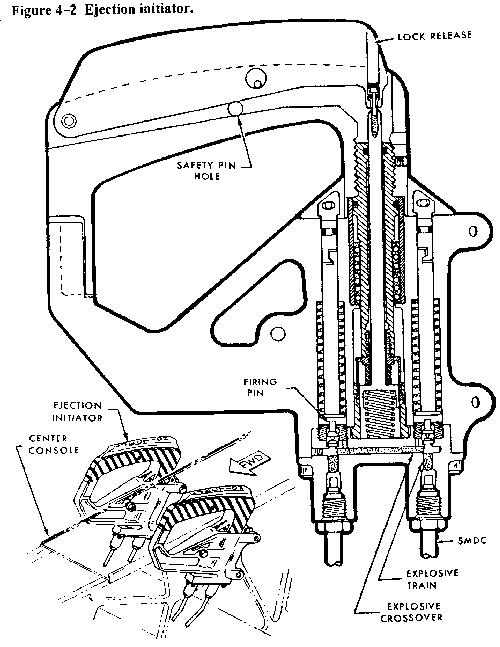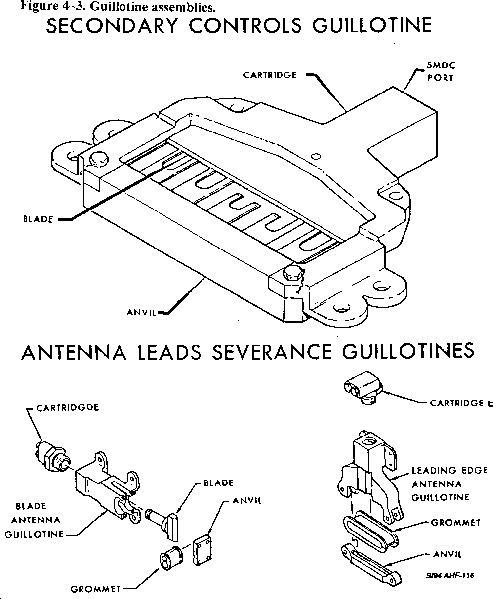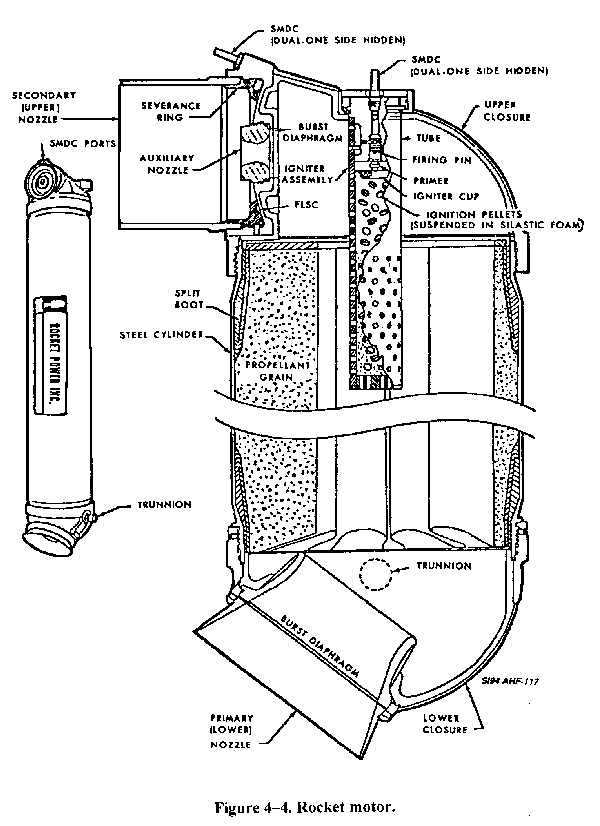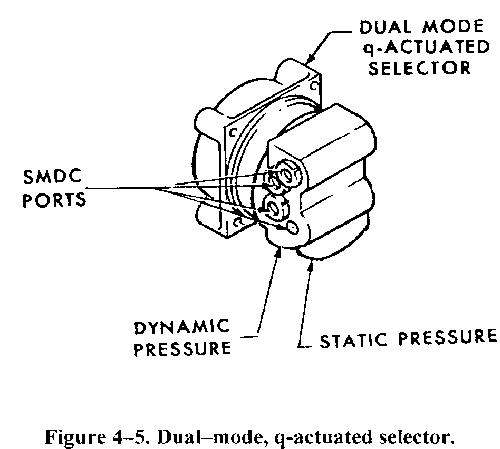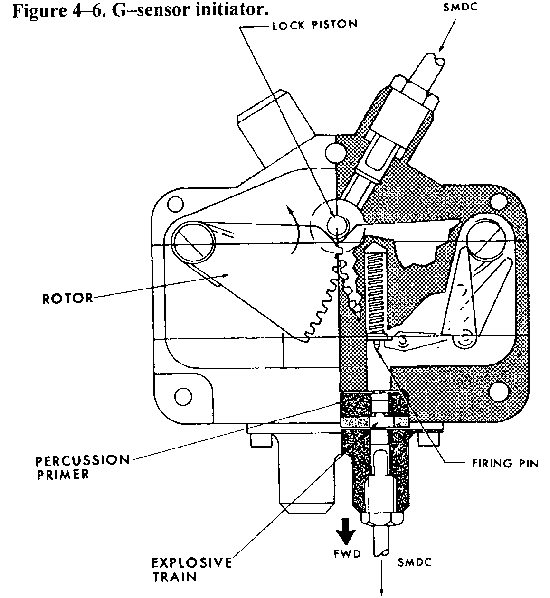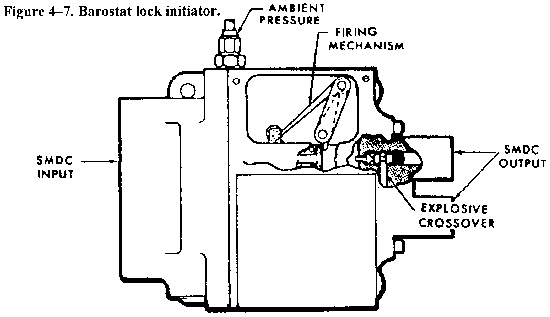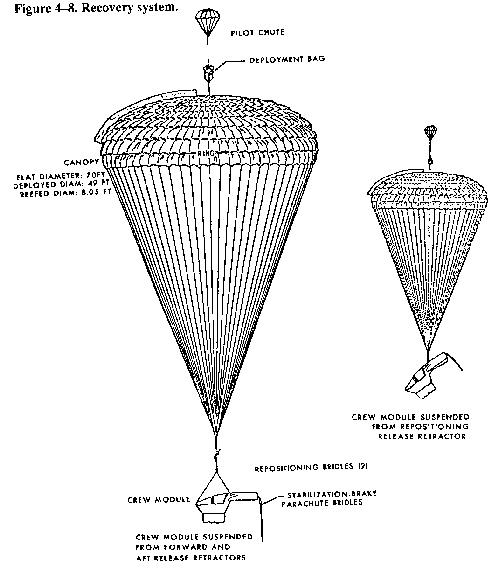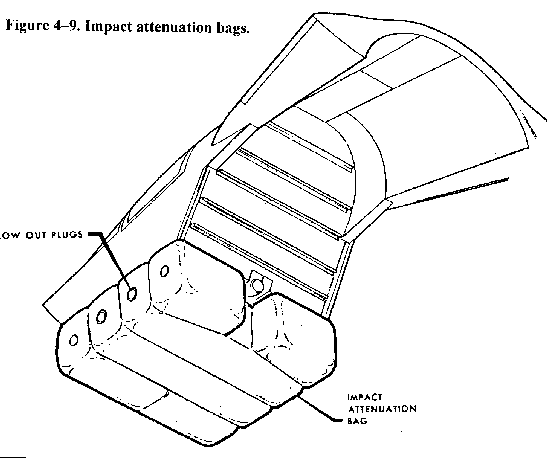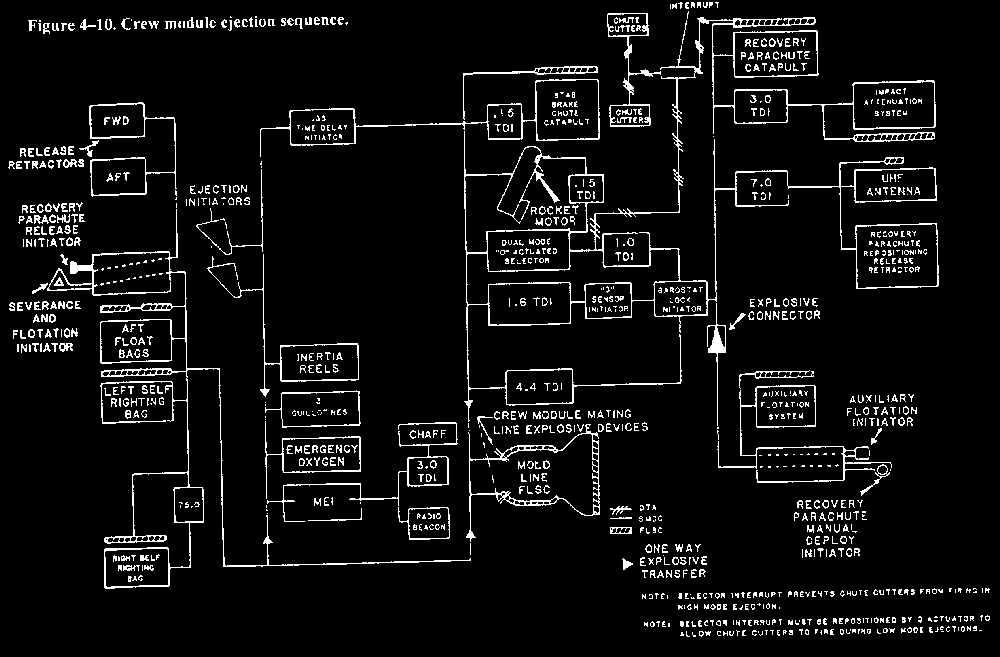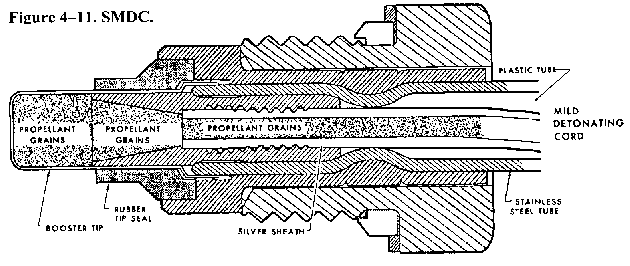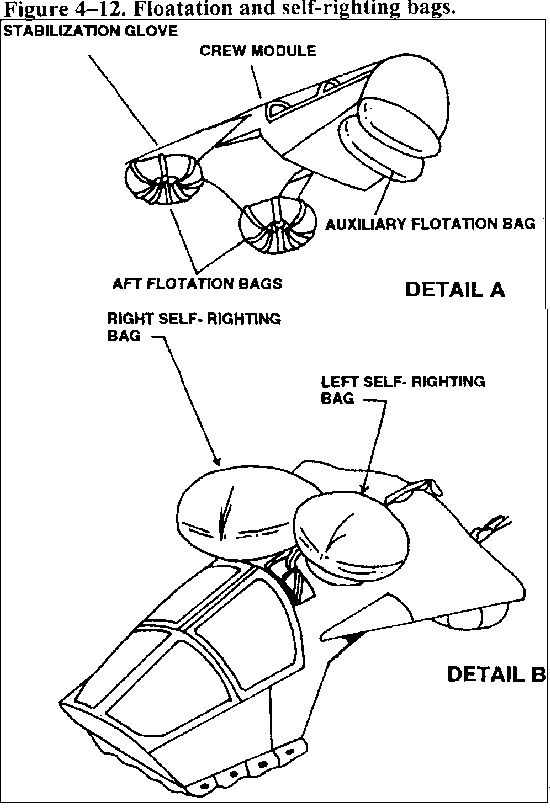The crew module is composed of many systems such as:
They are interconnected by means of shielded mild detonating cord (SMDC)
which acts as a stimulus transfer medium. The SMDC is provided with time
delay initiators (TDI) and one-way explosive transfers to ensure proper
sequencing of the various functions. Explosive transfer connectors are incorporated
in the system for firing redundancy. After actuation of the initiation system,
sequencing of all systems through landing and flotation is automatic. The escape
and survival systems consist of the crew module system and oxygen systems. The
oxygen systems are the normal (liquid) oxygen system, oxygen quantity and pressure
warning system, and emergency (gaseous) oxygen system.
219. System overview
Now that you have a general idea of what makes up the crew module ejection system,
let's take a closer look at the module system and the oxygen system. Let's begin
with the crew module.
Crew module. The crew module, (fig. 1 ), provides maximum comfort and protection
for both crewmembers during normal and emergency conditions. It is integrated into
the F-111 aircraft encompassing the pressurized cabin and forward portion of the
wing glove. The two crew seats are positioned side by side and have restraints
incorporated that enhance freedom of movement and comfort by eliminating the need
for a personal parachute and survival equipment to be fitted to the crewmembers.
Survival equipment and a recovery parachute are a part of the crew module system.
During an emergency, the crew module is separated from the aircraft and propelled
to a height sufficient for successful recovery throughout the aircraft performance
envelope. The system has features to reduce the landing shock on land or water and
has self-righting buoyancy, flotation capacity, and protects the crewmembers against
environmental hazards.
Oxygen system. The three functions of the oxygen systems are normal, quantity and
pressure warning, and emergency. During normal operations, the normal (liquid) oxygen
system supplies the crewmembers with breathing oxygen. When the normal oxygen system
malfunctions, low system pressure and low liquid oxygen quantities are indicated by a
normal oxygen quantity and pressure warning system.
Figure 1. F-111 crew module.
An emergency (gaseous) oxygen system supplies breathing oxygen to crewmembers during normal
oxygen system failure or during an ejection.
220. Pre-ejection
As stated earlier, the crew module escape system is made up of many systems which work together
during an ejection. These systems can be divided into three categories: pre-ejection, ejection,
and post-ejection. The pre-ejection category consists of the ejection initiators, guillotines,
emergency oxygen, mechanical explosive interrupt, a radio beacon, a 3.0-second TDI, chaff, and
a .35-second TDI. Let's take a closer look at some of the components that may be unfamiliar to you.
Ejection initiators. The ejection initiators are used to start the sequence to separate and eject
the crew module from a disabled aircraft, much like the ejection initiators used in any other
aircraft. However, as you can see in figure 2, the initiators used in the F-111 are quite
different in looks and operation. Safety pins are normally installed in the ejection initiator
handles to prevent accidental firing of the initiators, whenever aircraft maintenance is being
performed.
An ejection initiator on each side of the center console is within easy reach of both crewmembers
and permits either crewmember to start the crew module ejection sequence. Each initiator has a
D-shaped grip that must be squeezed and then pulled upward to actuate the built-in firing mechanism.
Squeezing the grip releases the initiator's built-in lock release. As the grip is pulled, the firing
mechanism first compresses the firing pin springs. As the grip reaches its upper limits, the spring
tension drives the firing pins into a percussion-type primer. The primer actuates the explosive train
and the explosive crossover.
Figure 2. Ejection initiator.
Guillotines. Guillotines sever antenna leads, secondary control cables, and an oxygen line. Refer
to the guillotines in figure 3. The cartridge is fired by the SMDC to actuate the guillotine
blade for severance. The secondary controls guillotine is located on the bottom surface of the
crew module floor in the left cheek area of the fuselage, the blade antenna leads guillotine is
located on the centerline of the crew module glove beneath access cover 2410, and the leading
edge antenna leads guillotine is located on the centerline of the crew module glove beneath
access cover 2420.
Figure 3. Guillotine assemblies.
Emergency oxygen. The emergency oxygen system provides both crewmembers with a 10-minute supply
of oxygen during ejection or when the normal aircraft oxygen system fails. During the pre-ejection
sequence, the emergency oxygen system is actuated explosively by the SMDC from the ejection initiators.
If the normal oxygen system fails during flight, the emergency system can be turned on manually.
Mechanical explosive interrupt (MEI). The MEI is a unit, that is controlled by the crewmember with a
chaff interrupt lever, that allows or stops the explosive propagation to the emergency radio beacon
and the 3.0-second TDI which, when fired, actuates the chaff dispenser. If the unit is closed, then
propagation is stopped. The TDI and emergency radio beacon are not activated. If the unit is open,
then propagation continues, activating both the emergency radio beacon and a 3-second TDI. The TDI
gives the crew module time to clear the aircraft before it fires, actuating the chaff dispenser.
Radio beacon. The radio beacon sends out radio signals for rescue purposes after an ejection. If
the MEI is in the open position, the beacon will automatically send out its signal. If the MEI is
closed, the radio beacon can be manually operated by a switch in the cockpit.
.35-second TDI. The .35-second time-delay initiator is fired by the SMDC from the ejection initiators
and delays the actuation of the components that make up the severance system.
221. Ejection
Now let's look at the ejection category which consists of flexible linear-shaped charges (FLSC), two.
15-second time-delay initiators, a rocket motor, a dualmode, q-actuated selector, a 1.6-second
time-delay initiator, a 4.4-second timedelay initiator, a 1.0-second time-delay initiator, a "G"
sensor initiator, and the select/interrupt valve.
Flexible linear-shaped charge. FLSC severs the module from the aircraft. It is installed around
certain covers and splice plates on the module to cut the metal for severance and is formed in a
chevron-shaped cross section for use in severance strips. Also, it is used to cut a larger hole in
the upper nozzle of the rocket motor during high-speed ejections. A booster tip is installed on each
end. The amount of explosive per foot of FLSC is selected to cut a specified thickness of metal.
.15-second TDI. Them are two .15-second time-delay initiators installed in the ejection system. One
delays firing of the stabilization/brake parachute catapult until the module has separated from the
aircraft and the other delays firing of the FLSC in the rocket motor upper nozzle in mode 1 until the
module has cleared the aircraft.
Rocket motor. In figure 4, you see that the rocket motor is composed of an upper closure or
compartment, a 9-inch by 58-inch steel cylinder case, and a lower closure or compartment. Starting
at the top of the upper closure, the SMDC propagation actuates the firing pin. This in turn fires
the percussion primer in the igniter cup, which then detonates the motor ignition pellets. These
ignition pellets are suspended in a foam that aids in their detonation. The rapidly detonating
ignition pellets cause the propellant grain in the steel cylinder to be ignited.
Figure 4. Rocket motor.
The rocket motor lower nozzle provides 27,000 pounds of thrust. To avoid excessive "g" forces to
the crewmembers, the rocket motor is provided with two concentric upper nozzles, secondary and
auxiliary. The small auxiliary nozzle in the center of the upper nozzle fires simultaneously with
the lower nozzle. This action provides 500 pounds of thrust to counteract slow-speed crew module
pitch up at speeds below 300 knots. At speeds above 300 knots, after a .15-second delay, the upper
nozzle burst diaphragm is severed by a flexible linear-shaped
charge (FLSC) to increase the exhaust-flow area, thus increasing its thrust. Because of the increase
in the exhaust-flow area, the rocket motor operating pressure is lowered, which results in reduced
thrust of 9,000 pounds at the lower nozzle and increases the upper nozzle thrust to 7,000 pounds.
This overall decreased thrust extends the operating time and reduces excessive "g" forces.
Dual-mode, q-actuated selector. In figure 5, you see the dual-mode, q-actuated selector. It
continuously senses aircraft speed and selects the appropriate time delay. The letter "q" is
used to identify forces or pressure required to actuate various pressure-sensitive aircraft devices.
Pressure from the pitot static system, or ram pressure, is sensed at one end of the q-actuated
selector, while dynamic pressure is sensed at the other end. Due to differential pressure, the
q-actuated selector allows activation of a 1-second TDI to the barostat lock initiator and blocks
propagation to the rocket motor upper nozzle when aircraft speed is less than 300 knots. When
aircraft speed is greater than 300 knots, differential pressure is changed so that the q-actuated
selector blocks propagation to the 1-second TDt and allows activation of SMDC to the. 15-second TDI
to the rocket motor upper nozzle to fire.
Figure 5. Dual-mode, q-actuated selector.
4.4-second TDI.
Another explosive train, with a 4.4-second time-delay initiator, is provided to back up
both the dual-mode, qactuated selector and the g-sensor initiator. This equipment ensures
that the barostat lock initiator is never activated more than 4.4 seconds after the rocket
motor is fired.
1.0-second TDI. This time delay allows the module to gain altitude during a mode 1 ejection.
Upon actuation, it fires the barostat lock initiator.
G-sensor initiator. The g-sensor initiator (fig. 6) is located in the survival equipment
explosive device compartment. A TDI delays firing the g-sensor initiator for 1.6 seconds after
rocket motor ignition during high-speed ejections. The forward motion of the crew module may be
relatively high immediately after ejection of the crew module at speeds above 300 knots. After
the forward motion decreases to approximately 2.2 (+/- 1 ) g' s, the g-sensor initiator fires
and activates the barostat lock initiator.
Figure 6. Dual-mode, q-actuated selector.
Select/interrupt valve. The select/interrupt valve works similarly to the mechanical explosive
interrupt. It either allows or blocks explosive propagation leading to the stabilization/brake
parachute cutters. The direction of propagation depends on the mode of ejection selected by the
dual-mode, q-actuated selector. When a mode 1 is selected, a detonation transfer assembly (DTA),
which is another type of mild detonating cord, repositions the select/interrupt valve. When the
recovery system operates, DTA propagation passes through the repositioned valve and fires the
cutters.
222. Post ejection (recovery system)
The post ejection system consists of the barostat lock initiator, the recovery parachute catapult,
the recovery parachute, a 3.0-second TDI, a 7.0-second TDI, the impact attenuation bag, the UHF
antenna, the recovery parachute repositioning release retractor, and the stabilization/brake
parachute cutters. Let's begin our discussion of this category with the barostat lock initiator.
Barostat lock initiator. The barostat lock initiator (fig. 7) consists of two operating trains.
Normally, an aneroid bellows in each explosive train is locked to prevent firing of the train,
constant cycling, and wear-out. Firing of the SMDC into the barostat inlet port initiates an explosive
charge that retracts the pins which normally lock the bellows. The aneroid bellows prevents the
firing of the explosive train until the module falls to within 14,000 and 16,000 feet. Below this
pressure altitude, atmospheric pressure compresses the bellows sufficiently to
release the firing pins that initiate the booster caps and continue the detonation sequence to remove
the recovery parachute and blade antenna severable cover and fire the recovery parachute catapult.
The barostat lock initiator is located on the explosive component support bracket in the rocket
motor compartment.
Figure 7. Barostat lock initiator.
Recovery parachute. In figure 8, you see the recovery parachute, a 70 foot, flat-diameter, ring
sail parachute equipped with a reefing line cutter. Reefing lines prevent the large parachute from
fully opening until the suspension lines are fully stretched. The parachute is stowed in a
compartment aft of the left crew seat bulkhead.
The recovery parachute is deployed into the airstream by a recovery parachute catapult. The
parachute is assisted in extending by a small pilot parachute. The recovery parachute is deployed
in a reefed or partially inflated condition to reduce the opening shock of the parachute to the
crew module. When the suspension lines are fully stretched, the reefing line is cut by the reefing
line cutter to allow the parachute to fully blossom. The recovery parachute is then suspended as it
appears in the smaller illustration on the right in figure 8.
Figure 8. Recovery parachute.
3.0-second TDI. The 3.0-second time-delay initiator allows for recovery parachute deployment before
activating the nitrogen bottles for the impact attenuation bag.
7.0-second TDI. This time delay allows the recovery parachute to fully blossom before firing the
FLSC to free the UHF antenna. It also fires the recovery parachute repositioning release retractor.
Impact attenuation bag. The impact attenuation bag (fig. 9) is made of neoprene coated nylon
cloth and is stored under the crew compartment. The bag has several interconnected chambers; and
when these chambers are inflated, the bag serves as a cushion and absorbs the landing shock of the
crew module.
Figure 9. Impact Attenuation Bag.
The bag contains blowout plugs of various sizes. These plugs are retained by shear pins. Upon landing,
the pins shear to release the blowout plugs, allowing the bag to deflate which reduces shock of crew
module impact to within allowable limits.
UHF antenna. FLSC severs the UHF antenna cover after 7 seconds. Once the cover has been severed,
the UHF antenna is free to extend and send out radio signals from the radio beacon.
Recovery parachute repositioning release retractor. There are three release retractors provided in
the recovery system. These retractors are the recovery parachute repositioning release retractor,
aft release retractor, and forward release retractor. Each retractor operates the same mechanically.
The repositioning release retractor provides a means for greater recovery loads to be absorbed by the
parachute clevis and to release this clevis for crew module repositioning and parachute bridle
deployment. After landing, the forward and aft release retractors provide a means for releasing
the recovery parachute bridle lines and thus the recovery parachute from the crew module. Upon
firing the retractor cartridge by means of SMDC, gas pressure actuates the retractor pin assembly
into the refractor housing to release the attached components.
Stabilization/brake parachute cutters. These cutters are fired by a detonation transfer assembly
and release the stabilization/brake parachute during mode 1 ejection.
223. Stabilization system
The stabilization system consists of the stabilization/brake parachute catapult, the
stabilization/brake parachute, stabilization glove, stabilization flaps, and pitch flaps.
Let' s begin our discussion of this system with the stabilization/brake parachute.
Stabilization/brake parachute. This is a 6-foot diameter hemisphere-type parachute that, by
means of bridle lines, is attached to the crew module at the aft end of the stabilization
glove. The parachute is pressure packed around the outer barrel of the parachute catapult
and stored in a compartment on the top aft end of the stabilization glove.
After the stabilization/brake parachute severable cover is severed, the parachute catapult
is fired. This ejects the parachute and catapult outer barrel aft and upward from the
stabilization glove. As the bridle lines pull tight, the outer barrel strips the deployment bag
from the parachute. This permits the parachute to deploy, slowing the module down and providing
lateral stability. If the ejection takes place below 300 knots, the stabilization/brake parachute
is cut away from the module concurrent with recovery parachute deployment to prevent possible
entanglement of the two parachutes.
Stabilization glove. The stabilization glove is an integral part of the crew module and is also
the forward part of the aircraft wing. This glove section serves to stabilizes the flight of the
crew module by preventing pitch down after its separation from the aircraft and until the recovery
parachute is supporting the module. It also houses the aft flotation bags and the stabilization/brake
parachute.
Stabilization flaps. The stabilization flaps are located forward of the forward pressure bulkhead on
the lower surface bulkhead. They are stowed in the retracted position and, when released, extend
approximately 64ø from the forward pressure bulkhead. At high speeds, the flap linkage stretches
under aerodynamic forces so that the flaps rotate to approximately 79ø. The spring-actuated
stabilization flaps, (which are released upon separation of the crew module from the aircraft),
reduce crew module pitch up at transonic speeds following separation from the aircraft.
Pitch flaps. The pitch flaps are attached to a hinged metal frame with a compressed spring, on
the lower aft end of the stabilization glove. Upon separation of the crew module from the aircraft,
the compressed spring actuates the pitch flaps to the lowered position. A synchronizing cable,
routed through pulleys on both flaps, assures simultaneous deployment. The pitch flaps lower the
trim angle of the module approximately 10ø to assist in horizontal stability.
Self-Test Questions
219. System overview
1. How are the crew seats arranged and how have they been designed for freedom of movement and
comfort?
2. What are the three functions of the oxygen system?
3. What is the purpose of the quantity and pressure warning function of the oxygen system?
220. Pre-ejection
1. What is required to be done to the ejection initiators whenever aircraft maintenance is being
performed?
2. Where are the guillotines located?
3. How is the emergency oxygen system actuated?
4. What is the MEI used for in the ejection sequence?
5. What is the radio beacon used for and how is it operated?
221. Ejection
1. How is FLSC used throughout the F-111 module system?
2. What is the purpose of the .15-second TDI's installed in the ejection system?
3. How is the rocket motor designed to avoid excessive "g" forces?
4. What is the purpose of the 4.4-second TDI in the pre-ejection?
5. What is the purpose of the select/interrupt valve?
222. Post-ejection
1. What components make up the post ejection system?
2. Where is the barostat lock initiator located?
3. How is the recovery parachute initially deployed?
4. What is the purpose of the repositioning release retractors?
223. Stabilization system
1. How and where is the stabilization/brake parachute stored?
2. During ejections below 300 knots, when is the stabilization/brake parachute cut away from the
module and why?
3. What is the purpose of the stabilization glove?
4. Upon separation of the crew module from the aircraft, how are the pitch flaps actuated?

